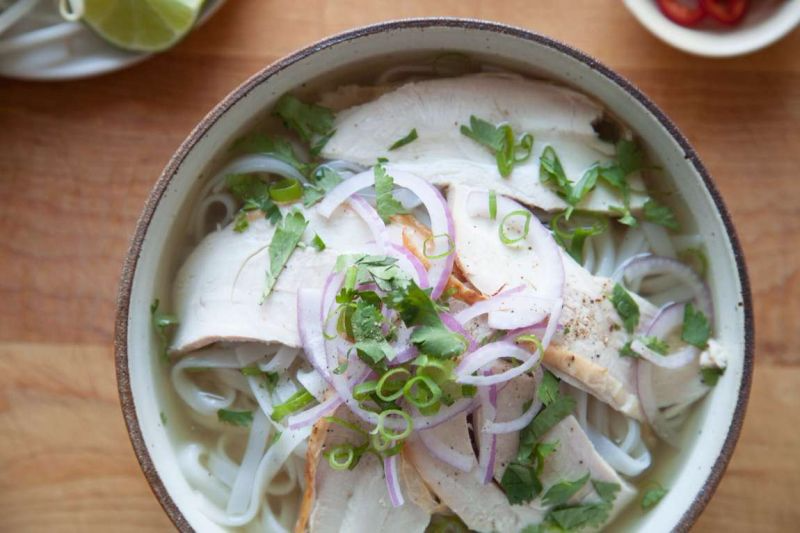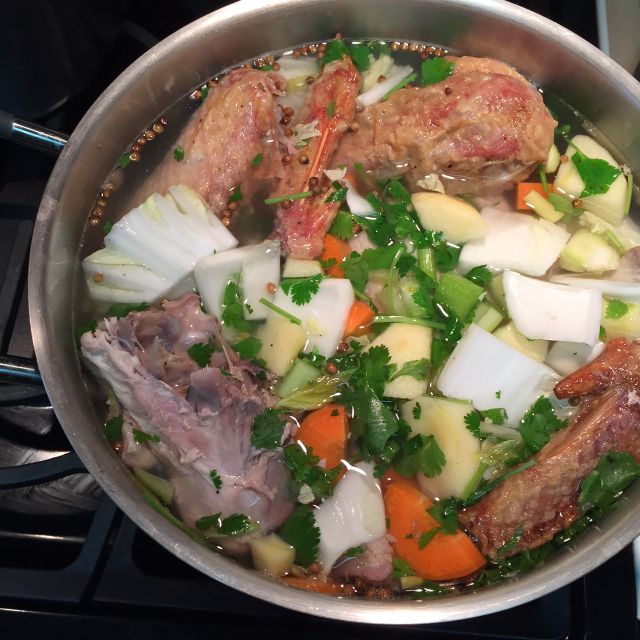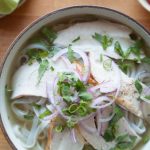
Not long ago someone on VWK asked if I had a turkey pho (phở gà tây) recipe. I was working on it and it took a while for me to figure it out, primarily because I’m not a turkey lover. As you may recall my mentioning over the years, our family abandoned Thanksgiving turkey in the 1980s when my mom admitted that the big bird cooked up dry and that she preferred goose, duck, Cornish game hens, and chicken. For that reason, come each November, I walk right past the turkey in the butcher counter and freezer cases. I’ve trained myself to neglect supermarket ads and deals on natural, heritage, and Butterball turkeys.
Earlier this year I confronted my turkey issues. ChefSteps.com had invited me to partner with them on Shanghai soup dumplings as well as soy milk and tofu video tutorials. They asked me to share other cooking insights and I thought of turkey pho. If you roast turkey around the holidays, how could the remains be turned into pho noodle soup? Maybe turkey pho would be a gateway for people to craft pho at home?
I didn’t include a recipe for turkey pho in The Pho Cookbook because it’s mostly a seasonal thing and plus, we didn’t have enough space in the book. To carryout the project for ChefSteps, I roasted several 11 to 13-pound turkeys to generate carcasses and other leftovers bits that would be used for developing a turkey pho recipe.
Negotiating turkey's flavor
One of the most challenging aspects of making good turkey pho (and perhaps another reason why I shied away from it) is how to downplay the strong roasted turkey flavor, which wiped out the subtleties of the charred onion and ginger. Pho is a delicate dance of spices and aromatics. In the end, I dumped the charring and instead dry sauteed the onion and ginger. I also chose to add lots of vegetables to counterbalance the roast turkey-ness of the turkey broth.
Is cloudy pho broth ok?
The other thing is that the roast turkey carcass can yield an extremely cloudy broth. My initial attempts were yucky like dirty dishwater. I strained it multiple times, let it rest, and skimmed off a strange layer of scum that accumulated on top but to no avail. The broth was unattractively cloudy and yellow-gray. Who'd want to eat that?
I was on the verge of breaking down and going cold turkey on turkey pho, admitting defeat. I looked for clues online and asked other culinary professionals whom I came across. At a Google campus banh mi book signing, the head chef who chaperoned me told me that roast turkey broth was always cloudy. A man in his late forties or early fifties, he had decades of cooking experience in Europe and America. Can I do anything to strain it or let it settle? Not really, he responded and shrugged.

But I persisted and around the fifth round, I began suspecting that the oil, fat, and other natural roasting residue were suspended in the broth to create that cloudiness. (If you ever wonder how I develop and write recipes, know that obsessive curiosity is involved.) Pho broth is usually made with raw proteins and during the simmering the fat releases slowly, separates, and rises to the top.
I suffered a couple nights of bad sleep and woke up one morning with the idea to rinse and use the kitchen sink water faucet to spray down the carcass with water. From the wells in the backbone came a lot of dark gunk, among my nemeses. I brewed the broth and some cloudiness remained, but it was handsome and reflected the pho spirit in looks and flavor.
And the taste? Really good. I was quite proud and happy. My husband was surprised and amazed. Jennifer and Genevieve, the team that shot the video (below) gobbled up the shoot leftovers. Hooray for the turkey pho victory!
By the time I’d simmered my last batch of turkey pho broth, I was won over to the roast turkey camp. This year, we’ve eaten enough roast turkey to make up for many lapsed Thanksgiving turkey dinners. In doing so, we realized that it tasted much better than we recalled. I also realized that turkey is eaten year round. Butchers at my local Whole Foods market and an indie grocer told me that they sell whole turkeys and turkey parts on a regular basis, not just around Thanksgiving. Going forward, I can roast a turkey whenever I want to and I have something to look forward to doing with leftover roast turkey parts.
Turkey pho video tips
Here’s the video that Chefsteps released as part of our recipe collaboration.
More pho tips
- Leftover Thanksgiving Turkey Pho Recipe for the Pressure Cooker and Multicooker (Instant Pot, Fagor Lux, etc.)
- How to Make Pho from The Pho Cookbook (a blueprint for using recipes in my James Beard Award-winning book!)
- Instant Pot Chicken Pho Recipe
Turkey Pho (Pho Ga Tay)
Ingredients
- 3 pounds roast turkey carcass wings, drumsticks, and other unwanted parts
- 1 Fuji apple, peeled, cored, and cut into ¾-inch chunks
- 1 large celery stalk, coarsely chopped
- 1 medium carrot, cut into thick rounds (scrub and use unpeeled, if you like)
- 12 ounces napa cabbage leaves, cut into large pieces
- 1 bunch (1.5 oz) cilantro, stems and leaves roughly chopped
- 4 star anise
- 3 whole cloves
- 1 tablespoon coriander seed
- A 3-inch cinnamon stick
- 1 large yellow onion, peeled, halved, and cut into thick slices
- Chubby 3-inch section ginger,l peeled, cut into thick slices, and bruised
- 15 cups water
- 2 teaspoons fine sea salt, plus more as needed
- 2 to 3 tablespoons fish sauce
Bowls
- 16 ounces dried narrow flat rice noodles, soaked in hot water until pliable, then drained
- 1 ¼ pounds cooked turkey meat, thinly sliced or torn into bite-size pieces
- 1 very small yellow or red onion, thinly sliced against the grain and soaked in water for 10 minutes
- ⅓ cup thinly sliced green onion, green parts only
- ⅓ cup chopped fresh cilantro, leafy tops only
- Pepper optional
Optional extras
- 3 cups bean sprouts
- 10 to 12 sprigs mint Thai basil, or a combination of both
- 2 limes cut into wedges
- 1 or 2 Thai, jalapeño, Fresno, or serrano chile, thinly sliced with seeds intact
Instructions
- Use your hands to break up the turkey backbone and wings (if using) into pieces so they will fit into the pot. Give them a very quick spray or rinse of water to remove visible impurities. Set in a large bowl with the apple, celery, carrot, cabbage, and cilantro.
- Put the star anise, cloves, coriander seed, and cinnamon in a small stockpot, about 8-quart capacity. Over medium heat, toast the spices for several minutes, shaking or stirring, until fragrant. Add the onion and ginger, stir for 45 to 60 seconds, until fragrant. Add 8 cups of the water to arrest the cooking process. Add the turkey, apple, vegetables, salt, and the remaining 7 cups water.
- Partially cover and bring to a simmer over high heat. Uncover and as needed, skim and discard scum. Adjust the heat to gently slimmer for 1 hour and 15 minutes. When done, let rest for 10 to 15 minutes.
- Retrieve the turkey pieces to make straining easier. Pour the broth through a muslin-lined mesh strainer positioned over a medium pot. Discard the solids. There should be about 12 cups of broth. Season with fish sauce and if needed, extra salt.
- Divide the noodles among 6 soup bowls. Meanwhile, bring the broth to a simmer over medium heat. At the same time, fill a pot with water and bring to a rolling boil for the noodles.
- For each bowl, place a portion of the noodles in a noodle strainer or mesh sieve and dunk in the boiling water. When the noodles are soft, pull the strainer from the water, shaking it to let water drain back into the pot. Empty the noodles into a bowl. Top with turkey, then add the onion, green onion, and cilantro. Finish with pepper.
- Taste and check the broth flavor again, adjust if desired, then raise the heat and bring it to boil. Ladle about 2 cups of broth into each bowl. Serve immediately with extras at the table.


















Rod from San Jose says
Thank you so much for your turkey pho recipe. The idea of making turkey pho has been kicking around in my mind for a few years, but I never experimented with it. I truly can't wait to give your recipe a go. Also, your recipe for Hanoi style pho from your book took my soup to the next level. Trotters and dried anchovies are magic. My toughest critics (my kiddos - who can eat soup almost every day) think my pho finally hit the mark with your Hanoi style recipe. Thanks for that one too.
Andrea Nguyen says
You are very welcome, Rod! The Hanoi pho recipe is a personal favorite. My mom adores it and I'm thrilled that you and your kids are too! You made my pho day.
Adam says
Hello! Excited to try this today. Is it possible for me to make the broth today and eat it tomorrow? Will it effect the flavor? Should I add the fish sauce tomorrow before I bring it back to boil? Thank you!
Andrea Nguyen says
Adam -- so sorry for this late response. Yes to adding the fish sauce before you bring the broth back to a boil. The fish sauce expresses its umami goodness best that way!
Grace says
I made the mistake of allowing the broth to come to a rolling boil and I feel like it made the broth murky. Very important just to allow it to simmer! Great recipe!
Andrea Nguyen says
Roast turkey is naturally kinda murky so yes, boiling will aggravate/stir things up. But the taste is still good! Thanks for writing!